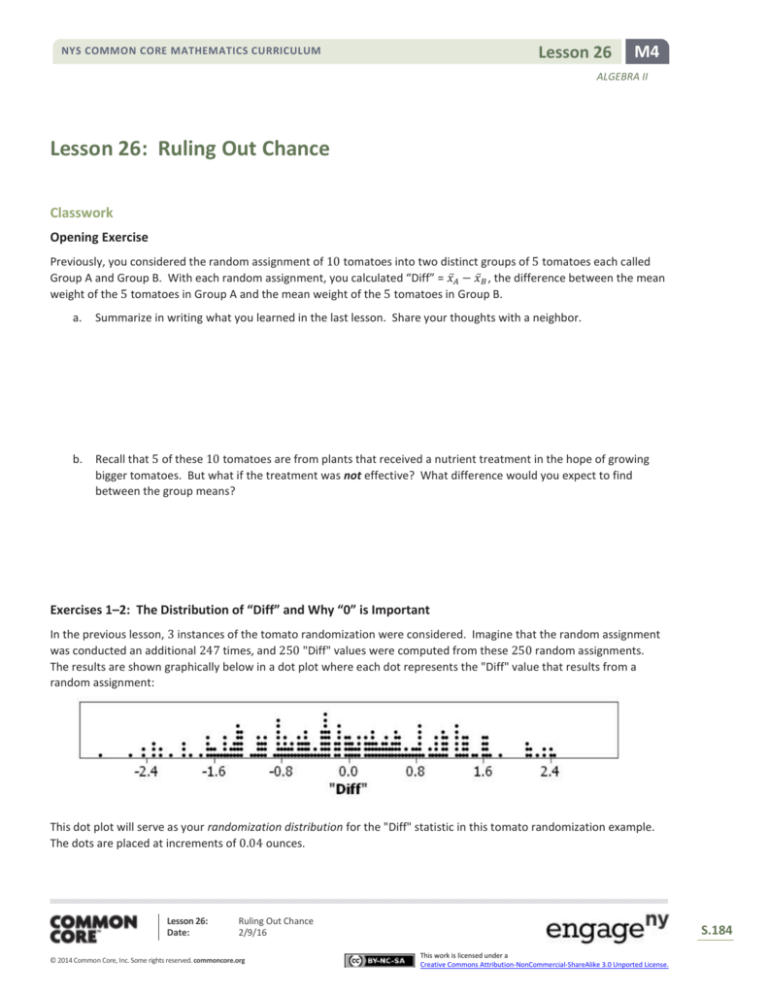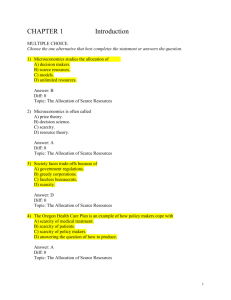
Lesson 26
NYS COMMON CORE MATHEMATICS CURRICULUM
M4
ALGEBRA II
Lesson 26: Ruling Out Chance
Classwork
Opening Exercise
Previously, you considered the random assignment of 10 tomatoes into two distinct groups of 5 tomatoes each called
Group A and Group B. With each random assignment, you calculated “Diff” = 𝑥̅𝐴 − 𝑥̅𝐵 , the difference between the mean
weight of the 5 tomatoes in Group A and the mean weight of the 5 tomatoes in Group B.
a.
Summarize in writing what you learned in the last lesson. Share your thoughts with a neighbor.
b.
Recall that 5 of these 10 tomatoes are from plants that received a nutrient treatment in the hope of growing
bigger tomatoes. But what if the treatment was not effective? What difference would you expect to find
between the group means?
Exercises 1–2: The Distribution of “Diff” and Why “0” is Important
In the previous lesson, 3 instances of the tomato randomization were considered. Imagine that the random assignment
was conducted an additional 247 times, and 250 "Diff" values were computed from these 250 random assignments.
The results are shown graphically below in a dot plot where each dot represents the "Diff" value that results from a
random assignment:
This dot plot will serve as your randomization distribution for the "Diff" statistic in this tomato randomization example.
The dots are placed at increments of 0.04 ounces.
Lesson 26:
Date:
Ruling Out Chance
2/9/16
© 2014 Common Core, Inc. Some rights reserved. commoncore.org
S.184
This work is licensed under a
Creative Commons Attribution-NonCommercial-ShareAlike 3.0 Unported License.
NYS COMMON CORE MATHEMATICS CURRICULUM
Lesson 26
M4
ALGEBRA II
1.
Given the distribution picture above, what is the approximate value of the median and mean of the distribution?
Specifically, do you think this distribution is centered near a value that implies "No Difference" between Group A
and Group B?
2.
Given the distribution pictured above and based on the simulation results, determine the approximate probability of
obtaining a "Diff" value in the cases described in (a), (b), and (c).
a.
of 1.64 ounces or more
b.
of −0.80 ounces or less
c.
within 0.80 ounces of 0 ounces
d.
How do you think these probabilities could be useful to people that are designing experiments?
Lesson 26:
Date:
Ruling Out Chance
2/9/16
© 2014 Common Core, Inc. Some rights reserved. commoncore.org
S.185
This work is licensed under a
Creative Commons Attribution-NonCommercial-ShareAlike 3.0 Unported License.
NYS COMMON CORE MATHEMATICS CURRICULUM
Lesson 26
M4
ALGEBRA II
Exercises 3-5: Statistically Significant "Diff" Values
In the context of a randomization distribution that is based upon the assumption that there is no real difference
between the groups, consider a "Diff" value of 𝑋 to be "statistically significant" if there is a low probability of obtaining a
result that is as extreme as or more extreme than 𝑋.
3.
Using that definition and your work above, would you consider any of the "Diff" values below to be statistically
significant? Explain.
a.
1.64 ounces
b.
−0.80 ounces
c.
Values within 0.80 ounces of 0 ounces
4.
In the previous lessons, you obtained "Diff" values of 0.28 ounces, 2.44 ounces, and 0 ounces for 3 different tomato
randomizations. Would you consider any of those values to be "statistically significant" for this distribution? Explain.
5.
Recalling that "Diff" is the mean weight of the 5 Group A tomatoes minus the mean weight of the 5 Group B
tomatoes, how would you explain the meaning of a "Diff" value of 1.64 ounces in this case?
Lesson 26:
Date:
Ruling Out Chance
2/9/16
© 2014 Common Core, Inc. Some rights reserved. commoncore.org
S.186
This work is licensed under a
Creative Commons Attribution-NonCommercial-ShareAlike 3.0 Unported License.
Lesson 26
NYS COMMON CORE MATHEMATICS CURRICULUM
M4
ALGEBRA II
Exercises 6-8: The Implication of Statistically Significant "Diff" Values
Keep in mind that for reasons mentioned earlier, the randomization distribution above is demonstrating what is likely to
happen by chance alone if the treatment was not effective. As stated in the previous lesson, you can use this
randomization distribution to assess whether or not the actual difference in means obtained from your experiment (the
difference between the mean weight of the 5 actual control group tomatoes and the mean weight of the 5 actual
treatment group tomatoes) is consistent with usual chance behavior. The logic is as follows:
6.
If the observed difference is “extreme” and not typical of chance behavior, it may be considered “statistically
significant” and possibly not the result of chance behavior.
If the difference is not the result of chance behavior, then maybe the difference did not just happen by chance
alone.
If the difference did not just happen by chance alone, maybe the difference you observed is caused by the
treatment in question, which, in this case, is the nutrient. In the context of our example, a statistically
significant "Diff" value provides evidence that the nutrient treatment did in fact yield heavier tomatoes on
average.
For reasons that will be explained in the next lesson, for your tomato example, "Diff" values that are positive and
statistically significant will be considered as good evidence that your nutrient treatment did in fact yield heavier
tomatoes on average. Again, using the randomization distribution shown earlier in the lesson, which (if any) of the
following "Diff" values would you consider to be statistically significant and lead you to think that the nutrient
treatment did, in fact, yield heavier tomatoes on average? Explain for each case.
Diff = 0.4, Diff = 0.8, Diff = 1.2, Diff = 1.6, Diff = 2.0, Diff = 2.4
Lesson 26:
Date:
Ruling Out Chance
2/9/16
© 2014 Common Core, Inc. Some rights reserved. commoncore.org
S.187
This work is licensed under a
Creative Commons Attribution-NonCommercial-ShareAlike 3.0 Unported License.
NYS COMMON CORE MATHEMATICS CURRICULUM
Lesson 26
M4
ALGEBRA II
7.
In the first random assignment in the previous lesson, you obtained a “Diff” value of 0.28 ounces. Earlier in this
lesson, you were asked to consider if this might be a "statistically significant" value. Given the distribution shown in
this lesson, if you had obtained a "Diff" value of 0.28 ounces in your experiment and the 5 Group A tomatoes had
been the “treatment” tomatoes that received the nutrient, would you say that the “Diff” value was extreme enough
to support a conclusion that the nutrient treatment yielded heavier tomatoes on average? Or, do you think such a
“Diff” value may just occur by chance when the treatment is ineffective? Explain.
8.
In the second random assignment in the previous lesson, you obtained a “Diff” value of 2.44 ounces. Earlier in this
lesson, you were asked to consider if this might be a "statistically significant" value. Given the distribution shown in
this lesson, if you had obtained a "Diff" value of 2.44 ounces in your experiment and the 5 Group A tomatoes had
been the “treatment” tomatoes that received the nutrient, would you say that the “Diff” value was extreme enough
to support a conclusion that the nutrient treatment yielded heavier tomatoes on average? Or do you think such a
“Diff” value may just occur by chance when the treatment is ineffective? Explain.
Lesson 26:
Date:
Ruling Out Chance
2/9/16
© 2014 Common Core, Inc. Some rights reserved. commoncore.org
S.188
This work is licensed under a
Creative Commons Attribution-NonCommercial-ShareAlike 3.0 Unported License.
Lesson 26
NYS COMMON CORE MATHEMATICS CURRICULUM
M4
ALGEBRA II
Lesson Summary
In the previous lesson, the concept of randomly separating 10 tomatoes into 2 groups and comparing the means of
each group was introduced. The randomization distribution of the difference in means that is created from multiple
occurrences of these random assignments demonstrates what is likely to happen by chance alone if the nutrient
treatment is not effective. When the results of your tomato growth experiment are compared to that distribution,
you can then determine if the tomato growth experiment’s results were typical of chance behavior.
If the results appear typical of chance behavior and near the center of the distribution (that is, not relatively very far
from a “Diff” of 0), then there is little evidence that the treatment was effective. However, if it appears that the
experiment's results are not typical of chance behavior, then, maybe, the difference you are observing didn't just
happen by chance alone. It may indicate a statistically significant difference between the treatment group and the
control group, and the source of that difference might be (in this case) the nutrient treatment.
Problem Set
In each of the 3 cases below, calculate the "Diff" value as directed, and write a sentence explaining what the "Diff" value
means in context. Write the sentence for a general audience.
1.
Group A: 8 dieters lost an average of 8 pounds.
Group B: 8 non-dieters lost an average of 2 pounds over the same time period.
Calculate and interpret "Diff" = the mean of Group A minus the mean of Group B.
2.
Group A: 11 students were on average 0.4 seconds faster in their 100 meter run times after following a new
training regimen.
Group B: 11 students were on average 0.2 seconds slower in their 100 meter run times after not following any new
training regimens.
Calculate and interpret "Diff" = the mean of Group A minus the mean of Group B.
3.
Group A: 20 squash that have been grown in an irrigated field have an average weight of 1.3 pounds.
Group B: 20 squash that have been grown in a non-irrigated field have an average weight of 1.2 pounds.
Calculate and interpret "Diff" = the mean of Group A minus the mean of Group B.
Lesson 26:
Date:
Ruling Out Chance
2/9/16
© 2014 Common Core, Inc. Some rights reserved. commoncore.org
S.189
This work is licensed under a
Creative Commons Attribution-NonCommercial-ShareAlike 3.0 Unported License.
NYS COMMON CORE MATHEMATICS CURRICULUM
Lesson 26
M4
ALGEBRA II
4.
Using the randomization distribution shown in the Exit Ticket, what is the probability of obtaining a "Diff" value of —
0.6 or less?
5.
Would a "Diff" value of −0.6 or less be considered a “statistically significant difference”? Why or why not?
6.
Using the randomization distribution shown in the Exit Ticket, what is the probability of obtaining a "Diff" value of
−1.2 or less?
7.
Would a "Diff" value of −1.2 or less be considered a “statistically significant difference”? Why or why not?
Lesson 26:
Date:
Ruling Out Chance
2/9/16
© 2014 Common Core, Inc. Some rights reserved. commoncore.org
S.190
This work is licensed under a
Creative Commons Attribution-NonCommercial-ShareAlike 3.0 Unported License.










